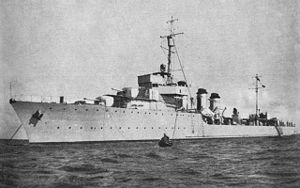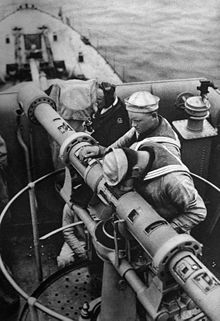- ORP Wicher (1928)
-

Wicher, the lead ship of her classCareer (Poland) 
Name: ORP Wicher Namesake: Polish: Gale Ordered: 2 April 1926 Builder: Chantiers Navals Français, Blainville-sur-Orne, Caen Laid down: 19 February 1927 Launched: 10 July 1928 Commissioned: 8 July 1930 Fate: Sunk 3 September 1939 Notes: 54°36′N 18°46′E / 54.6°N 18.767°E (remnants) General characteristics Class and type: Wicher-class destroyer Displacement: 1,540 t
full: 2,010 tLength: 106.9 m (351 ft) Beam: 10.5 m (34 ft) Draught: 3.5 m (11 ft) Speed: 33.8 knots (62.6 km/h) Complement: 162 Armament: 1930:
- 4 x 130 mm wz. 19/24 Schneider-Creusot Model 1924 guns
- 2 x 40 mm wz. 28 Vickers-Armstrong 2 pdr Mk II AA guns
- 2 x double 550 mm/533 mm/450 mm torpedo launchers
- 2 x 240 mm Thornycroft depth charge launchers
- 2 x Wz BH200 depth charge launchers
- 60 x wz. 08 naval mines
1939:
- 4 x 130 mm wz. 19/24 Schneider-Creusot Model 1924 guns
- 2 x 40 mm wz. 28 Vickers-Armstrong 2 pdr Mk II AA guns
- 4 x 13,2 mm Hotchkiss wz. 30 HMGs (2x2)
- 2 x double 550 mm/533 mm/450 mm torpedo launchers
- 2 x Wz BH200 depth charge launchers
- 60 x wz. 08 naval mines
ORP Wicher, the lead ship of the Wicher class, was a Polish Navy destroyer. She saw combat in the Invasion of Poland, which began World War II in Europe. The destroyer was sunk by German bombers on 3 September 1939.[1]
Contents
History
The ship was built at Ateliers et Chantiers Navals Français, Blainville-sur-Orne, near Caen and construction took 4 years, almost two more than initially planned. The steam turbines were built by Ateliers et Chantiers de la Loire in St. Nazaire, while the armament was mounted in the French Marine arsenal in Cherbourg. The ship was launched on 10 July 1928, but it was not until 8 July 1930, when she was finally commissioned by the Polish Navy in Cherbourg harbour. She was named ORP Wicher (Polish: gale), in accordance with the French tradition of naming destroyers after meteorological phenomena. A week later she arrived at Gdynia and became the first modern ship of the Polish naval forces. Her sister ship, Burza, was started at the same time, yet was finished two years later, roughly four years after the initial deadline.
During the Interbellum, Wicher served a variety of roles, mostly political. For instance, on 15 June 1932, she was sent to the port of the Free City of Danzig (Gdańsk) to meet two British destroyers entering the port and to underline[2] the Polish political influence in that city. In March 1931 she also sailed to Madeira, from where she brought Marshal of Poland Józef Piłsudski and his family. This passage was the greatest distance Wicher ever travelled from Poland. She also visited Stockholm in August 1932, Leningrad in July 1934, Kiel in June 1935 and Helsinki and Tallinn the following month. In 1937, while serving as a school ship, she visited Pärnu, Narva, Vyborg, Turku, Mariehamn, Nexo, Skagen, Assens and Helsingor, as well as Tallinn and Riga.
By late 1930s it was apparent that the armament was insufficient. The French artillery had a low rate of fire and the ship had inadequate protection against aerial bombardment. To solve the problem, in the autumn of 1935 two double 13.2 mm Hotchkiss heavy machine guns were added. On 18 March 1939 the ship, along with the entire "Counter-torpedo Flotilla", was put on alert due to the Memel Crisis. Although the alert was called off a week later, the training cruises were halted. At the same time, most Polish surface vessels were prepared to be withdrawn to British ports in Operation Peking. Wicher and Gryf were the only major ships left at Gdynia harbour for the protection of the Polish shore.
Combat
After the Invasion of Poland on 1 September 1939, she repelled a bombing raid at Gdynia, after which she sailed for the Hel naval base, from where she was to commence Operation Rurka, an attempt to lay a minefield at the entrances to Gdańsk Bay. Wicher was to shield the operation, carried out by Gryf, a heavy minelayer,[1] from the side of the German port of Pillau, assisted by six minesweepers and two gunboats. After boarding naval mines from a floating depot, Gryf and her flotilla headed for Hel Peninsula. En route she was attacked by a squadron of 33 German Ju-87B dive bombers and suffered several close misses, which caused minor damage and killed her captain. In what became known as the Battle of the Gdańsk Bay, Wicher was not hit directly, but the German planes scored several close hits, breaking all windows on the bridge and fracturing the hull in several places. After arriving at Hel harbour at 18:45, Wicher set off for the area of operations, arriving around 22:00. Wicher's captain, Commander Stefan de Walden, did not know that the operation had been called off and in fact shielded the empty bay and not the Polish flotilla, which was anchored at Hel.[1]
Soon after her arrival, Wicher's crew spotted two German destroyers, yet she did not open fire on them, not wanting to attract attention to the Polish units that were supposed to be operating in Gdańsk Bay. Later that night she also spotted a Leipzig-class cruiser. At approximately 01:00 on 2 September Wicher returned to Hel and discovered that the operation had been called off. In the morning of 3 September 1939, while moored in a harbour, Gryf and Wicher were attacked by two German destroyers, Z1 Leberecht Maass and Z9 Wolfgang Zenker, firing at a range of 9 nautical miles. Polish warships and a shore battery repulsed the attack, with Gryf scoring two hits. After that the German squadron put up a smoke barrier and withdrew.[1] Later that day Wicher, still in harbour, repulsed two air raids. However, in the third attack at approximately 15:00 she was attacked by two group of planes, and the German Luftwaffe scored four hits. Two bombs hit amidships, one hit the bow and the other was a close miss, yet it managed to fracture the hull at several places on the starboard side. Wicher started to sink and the crew made it ashore, where they joined the land defence of Pomerania. One sailor was killed and 22 wounded in the air attack.
After the end of hostilities, in November 1939 the Germans raised the wreck and hauled it to shallow waters. According to some sources, she was to be raised from the bottom, repaired and commissioned into the Kriegsmarine under the name of Seerose. However, these plans never succeeded and Wicher's wreck survived the war.
After World War II, in 1946, she was again raised and hauled outside the port to the area of Jastarnia. There she served as a target for aerial bombardment practice until 1955. In 1963 she was partially scrapped. The remaining part, in approximate position 54°40′N 18°32′E / 54.667°N 18.533°ECoordinates: 54°40′N 18°32′E / 54.667°N 18.533°E, consists of just a quarter of the hull, mostly two funnels and the rudder.
References
- ^ a b c d Peszke, Michael Alfred (February 1999). Poland's Navy, 1918-1945. Hippocrene Books. p. 37. ISBN 0781806720.
- ^ 15. Juni: Einlaufen des polnischen Zerstörers "Wicher" in den Danziger Hafen als Drohgebärde gegenüber Deutschland und Danzig [1]
External links
- Wicher and her sister ship Burza side by side at Tallinn (Estonia) harbour during the goodwill visit
- Wicher immediately after sinking
Wicher-class destroyer Preceded by: None · Followed by: Grom class
List of ships of the Polish NavyCategories:- Wicher class destroyers
- World War II destroyers of Poland
- Ships of the Polish Navy
- World War II shipwrecks in the Baltic Sea
- 1928 ships
- Ships built in France
- Maritime incidents in 1939
- Ships sunk by aircraft
Wikimedia Foundation. 2010.

